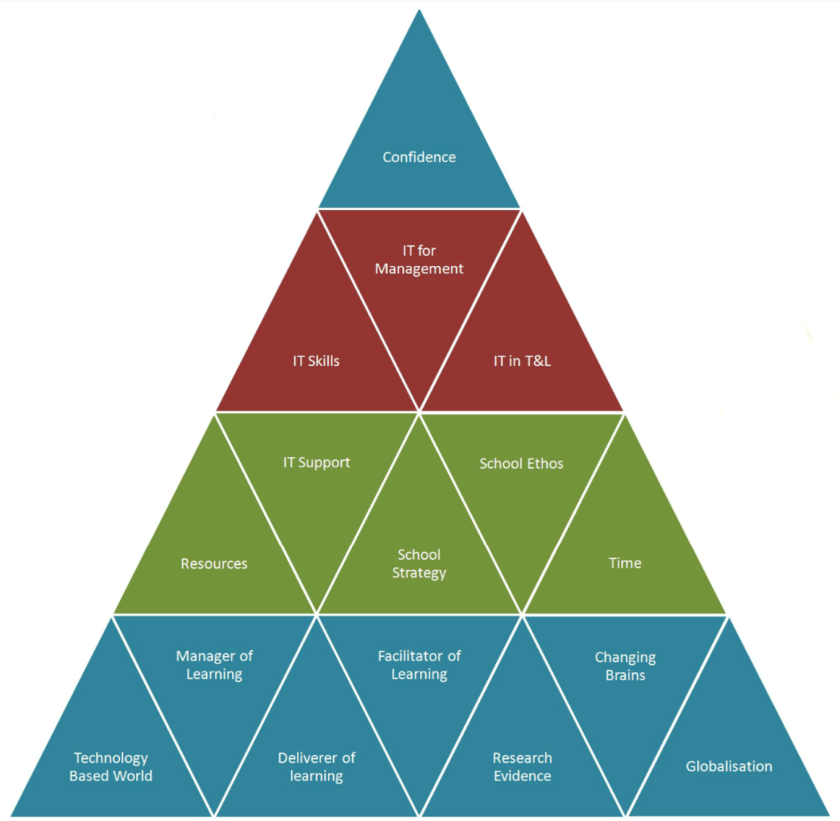
I have previously shared a couple of post discussing an EdTech model I shared at the GESS conference back in 2013, now being up to the third of four layers within the model. The third layer assumes you have already decided the key reasons why you want to invest in and use Technology in your school, this being layer 1. I note that Technology is my preferred term to EdTech. Layer 3 also assumes you have put the relevant fundamental building blocks in place as part of layer 2. So, what is the third layer about?
Layer 3
The third layer focusses on what I considered to be the three dimensions of technology use within a school, and the need for relevant training in these areas. These areas being:
IT Skills
This is the basics of using IT and using tools so includes understanding file types, sizes, sharing files, using email, etc. It is being able to log in, connect peripherals and change your password. All staff need to have a basic understanding of the technology they are using, as without this it is unlikely, they will ever reach a point of confidence and then mastery of using technology in school. I often described this as Teaching of IT as the focus is on developing IT Skills. We need to ensure staff are supported in this area. Thinking about it further, I believe this area would include cyber security and data protection although back in 2013 I am not sure I had included these areas.
IT for Management
There will also be some administrative work in teaching with IT generally being part of this, whether it is writing student reports, gathering performance data, following up on behaviour issues or many other issues. Technology can allow us to streamline processes to make these tasks quicker or simpler. I am often surprised how often staff don’t know about simply email rules in outlook or how they can use categories to help manage emails. Note: I mention emails as so much of the administrative load seems to revolve around reading and responding to emails, or to messages now in Teams or other platforms. At a more advanced level we can then move on to the use of solutions such a PowerAutomate to try to automate more and more of the administrative workflows however I will admit there is much more work that can be done in this area.
I also think we need to continue to examine the administrative side to teaching and identify where it adds value, for if a task doesn’t add value, I would suggest it isnt worth doing. There is also an opportunity to make use of technology to do things differently such as replacing termly reports with more live, but automatically generated, performance data derived through the use of machine learning and AI based platforms.
IT for Teaching and Learning
This is the likely most important element in this layer, that of using technology in the classroom. It is about ensuring teaching staff have the ability to use technology effectively in their classroom, their lessons and the learning activities they create. I suppose on reflection this particular layer could be sub-divided further. Thinking about the TPACK model, this section could include Technological Pedagogical Knowledge (TPK) and Technological Content Knowledge (TCK). Looking at it a different way it could include teaching using technology, where technology enhances or redefines a learning activity or process, plus teaching through technology, where the technology is an essential vehicle for the learning. Now I admit I find these two categories sometime difficult to separate however I will try to clarify. Teaching using technology might be the use of OneNote to allow students to collaborate on a project so technology is just another tool in the learning experience, whereas teaching through technology might be using VR or Minecraft, in which case the technology becomes central to the learning experience. Am hoping the above clarifies this however please forgive me if it does not.
Looking back, I would also suggest that my focus was very much the bricks and mortar school and classroom and I underplayed the potential for technology to allow for learning beyond the physical confines of a school and also beyond the confines of the curriculum. The potential for online learning has certainly been highlighted over the last year and a half during the pandemic, something I don’t think I fully considered back in 2013.
Conclusion/Reflections
Looking back on the third layer I feel the balance implied by the three triangles of equal size suggested an equal value to the three strands I proposed. This clearly isnt the case. If anything, the teaching and learning section should likely be the largest, and further subdivided, while the IT for Management section should likely be the smallest, as we should be trying to reduce the administrative burden on teachers, to allow them to focus on teaching and learning.
That said, the final peak of my model, layer 4, was always about staff being confident enough to use technology or to be more exact, to experiment and try different tools and technology solutions. Only through experimentation will teachers find the tools that work best for themselves and their students, and they will only do this if they feel safe and confident enough to do so. For this confidence to occur we need the basic skills, the ability to do the management side of education using the technology tools provided, and most importantly the skills to use technology in teaching and learning itself. So maybe this layer could be more nuanced, however at a basic level it may still be correct.

